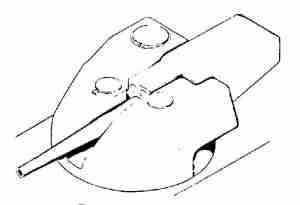Articles >>
Cleft Turret
Category: Term of the day

It is a type of turret where the gun is set between the two turret crewmen, one either side. The true cleft turret should not be confused with the narrow, high turret of the M60 A1E2, a tank using the 152 mm gun from the unsuccessful Sheridan reconnaissance vehicle programme. The true cleft turret has a shape rather as if one had taken half an orange, placed it on a flat plate and then pressed a pencil down into it so that the upper part of the pencil was level with the orange.
The particular advantage that this system bestows is that the gun can depress fully without the constraint of the turret roof. If the height of the turret roof, or strictly speaking the height of the turret either side of the cleft can be reduced then the weight of armour required to provide the desired level of protection can also be reduced. As the breech of the gun is lying in the valley between the two sides of the turret it is afforded a measure of protection.
Despite the fact that the cleft affords some protection, it also causes some design problems. Elevation, and not depression, of the gun now becomes a major limiting factor, the turret ring below the turret (engine decks) being the limiting factor. As the gun is now disassociated from the crew, loading and servicing is difficult. Also, trials have proved that the isolation of the turret crewmen on their separate sides of the turret creates psychological problems which have to be taken into account, especially when operating the tank for long periods closed down. An external autoloader becomes essential and care must be taken to ensure that the elevation of the gun is not obstructed by spent cases and debris. Because servicing the gun is virtually impossible without getting out of the turret, reliability is of paramount importance. As the gun is lying in the cleft of the turret and gun recoil is not constrained by turret ring diameter, it may be possible to reduce the size of the tank. However, by its very nature, the gun divides the turret in two halves which can lead to crew control problems. However, as two identical crew stations are required, crew duties, particularly for surveillance, can be relatively easily exchanged. |
New Upgrades Enhance Sighting and Add More Firepower to LCT20 Turrets
08.09.2011
General Dynamics UK cements Lockheed Martin UK`s position in Scout team
10.12.2010
Lockheed Martin UK Starts Scout Turret Development
03.12.2010
General Dynamics UK debuts Scout SV turret at DVD 2010
28.06.2010
Discuss
